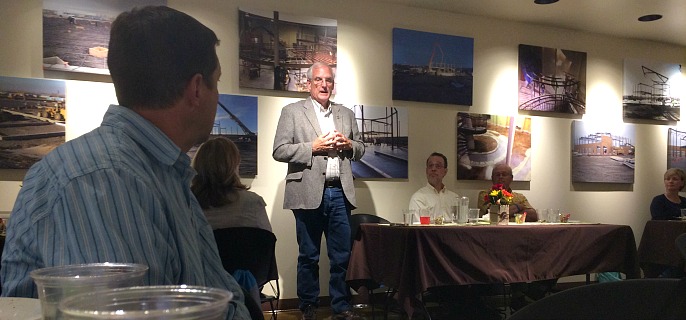
CONTRIBUTED PHOTO

The Northeast Oregon Water Association, Eastern Oregon Women’s Coalition, Hermiston Chamber Government Affairs Team, Pendleton Chamber and others worked together with Hansell to organize Dembrow’s visit.
In his e-newsletter, Dembrow offered his thoughts on Northeast Oregon. Here are Dembrow’s comments:
Back in February Senator Bill Hansell (R-Athena), who represents much of Eastern Oregon and who serves with me on the Environment and Natural Resources Committee, invited me to come out to his district and see for myself what’s happening there in terms of agriculture, water use, and new industry. I jumped at the chance.
First of all, Bill Hansell is a great guy, and the opportunity to spend a few days with him, stay at his home, and see where he grew up and served as Umatilla County Commissioner for 32 years was very appealing. Second, Bill had done something similar last year with my predecessor, Jackie Dingfelder, and she had been very positive about the experience. (In fact, their time with the ranchers of Wallowa County most likely led to the subsequent compromise wolf management law that was passed in 2013.) Finally, I knew that the area of Oregon along the Columbia River had managed to escape the worst of the recession virtually unscathed (in fact, its economy had grown), and I wanted to have a leisurely few days to see firsthand why that might be so.
Well, I quickly gave up on any thoughts of leisure. My three days were to have no leisure in them. Check out this itinerary. And this is just for the first two days, in Boardman, Hermiston, and Pendleton! (Friday was spent on the Confederated Tribes of the Umatilla Indian Reservation and at Eastern Oregon University.) It was a continual series of things to see, things to learn, people to meet, remarks to make. Actually, it was fascinating, much more so than I had envisioned, a very positive exercise in urban-rural dialogue. It provided much food for thought.
There’s too much for me to tell in detail, but here are some of the takeaways:
• Agriculture in this area is much more than just wheat and potatoes. Because of the growing number of agricultural processing (e.g., making frozen or dried food, dairy products, ethanol, seed) and transportation facilities at the Port of Morrow in Boardman (and to a lesser extent elsewhere), many thousands of good jobs are being created in connection with agriculture.
• The soil in this region is capable of growing high-value crops if there is access to water. An acre of non-irrigated land is worth around $1,200 an acre. With irrigation, the acre’s value rises to around $16,000 an acre.
• With the Columbia River rolling close by, you would think that it would be a simple matter of pumping out water from the big river to allow the region to reach its potential. However, this would require us to solve an extremely complicated set of legal and environmental challenges. We need to find an affordable and acceptable way to capture water during the plentiful winter months to use during the growing season, and at the same time help restore the fish runs in the tributary streams. So far, we’ve not been able to find agreement over the right way to proceed.
• Portland’s economy is closely tied to what is occurring in Eastern Oregon.
• More people should know about and visit the SAGE (Sustainable Agriculture and Energy) Center off the freeway in Boardman and the Tamáskslit Center on the Umatilla Reservation just east of Pendleton. These are excellent museums and interpretive centers where one can learn a lot.
• The region is a growing center for low-carbon energy, with its proliferation of wind farms, ethanol, waste-to-gas, electricity/steam co-generation, and of course hydroelectric power.
I admire the leadership of the Confederated Tribes of the Umatilla. These women and men are doing some amazing, forward-thinking things (e.g., the Cayuse Technology Center), while holding on to traditional values and modes of decision-making. They are committed to improving salmon and Pacific lamprey runs on the Columbia and Umatilla Rivers and to restoring other “first foods,” such as traditional roots and berries.
It’s not clear to me why more young people from other parts of the state (and country) are not attending Eastern Oregon University in La Grande. It combines the cost benefits of a public university with the benefits of a small college with lots of faculty attention and support. It’s in a really beautiful part of the state. It plays an important role in the cultural, economic, and intellectual vitality of Eastern Oregon. We need to figure out a way to beef up Eastern’s enrollment for the long haul.
For all that I was able to learn during this tour, I owe a great deal to Sen. Hansell (and his wonderful wife, Margaret), of course, but also to a small group of civic-minded women, who call themselves the Eastern Oregon Women’s Coalition. Many thanks to Bobby, Fran, Cynda, Cam, Debbie, and the others, who organized and supported much of the tour. And to J.R. Cook and the other young East Oregonians from the Northwest Oregon Water Association, who are so committed to building a region where they and their families can remain in their homes and retain their rural lifestyles.
I’ve invited members of the Eastern Oregon Women’s Coalition and the Northeast Oregon Water Association to come to one or more of my constituent coffees and town halls to enter into dialogue with local people here.
More Stories from Northeast Oregon Now:
67 Students Graduate from UHS on Saturday
Marijuana Spills onto Interstate








